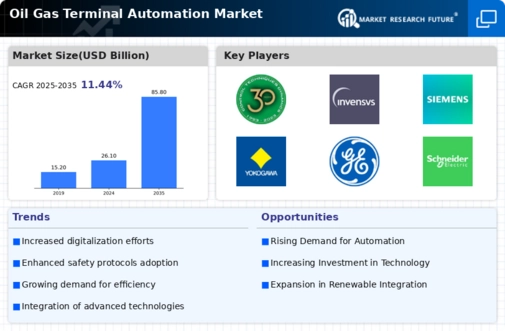Regulatory Compliance
Stringent regulatory frameworks governing safety and environmental standards are compelling operators within the Global Oil Gas Terminal Automation Market Industry to adopt automated solutions. Compliance with regulations such as the International Maritime Organization's MARPOL convention necessitates the implementation of advanced monitoring systems. Automation helps in ensuring adherence to these regulations by providing real-time data and analytics for better decision-making. As a result, companies are increasingly investing in automation technologies to mitigate risks associated with non-compliance, which can lead to hefty fines and operational disruptions.
Global Energy Transition
The ongoing global energy transition towards cleaner and more sustainable energy sources is influencing the Global Oil Gas Terminal Automation Market Industry. As companies seek to reduce their carbon footprints, automation plays a crucial role in optimizing energy consumption and minimizing waste. Automated systems can monitor emissions and ensure compliance with environmental standards, thus supporting sustainability initiatives. This shift is likely to drive demand for innovative automation solutions that align with the goals of energy transition, fostering a more sustainable operational landscape in the oil and gas sector.
Market Growth Projections
The Global Oil Gas Terminal Automation Market Industry is projected to experience substantial growth, with estimates indicating an increase from 26.1 USD Billion in 2024 to 85.8 USD Billion by 2035. This growth trajectory suggests a robust demand for automation technologies, driven by factors such as technological advancements, regulatory compliance, and the need for operational efficiency. The compound annual growth rate of 11.44% from 2025 to 2035 further emphasizes the market's potential. Such projections highlight the importance of strategic investments in automation solutions to capitalize on emerging opportunities within the industry.
Technological Advancements
The Global Oil Gas Terminal Automation Market Industry is experiencing rapid technological advancements that enhance operational efficiency and safety. Innovations such as advanced sensors, IoT integration, and AI-driven analytics are transforming traditional terminal operations. For instance, the implementation of predictive maintenance technologies can reduce downtime and maintenance costs significantly. As terminals adopt these technologies, they are likely to see improved throughput and reduced operational risks. The market is projected to grow from 26.1 USD Billion in 2024 to 85.8 USD Billion by 2035, indicating a strong demand for automation solutions driven by these advancements.
Rising Demand for Efficiency
The need for enhanced operational efficiency is a primary driver in the Global Oil Gas Terminal Automation Market Industry. Companies are under pressure to optimize their processes to reduce costs and improve productivity. Automation technologies facilitate streamlined operations, allowing for faster loading and unloading of cargo, which is crucial in a competitive market. The projected compound annual growth rate of 11.44% from 2025 to 2035 underscores the urgency for terminals to adopt automation solutions. This trend is particularly evident in regions with high throughput requirements, where efficiency gains can translate into substantial financial benefits.
Increased Investment in Infrastructure
Significant investments in oil and gas infrastructure are propelling the Global Oil Gas Terminal Automation Market Industry forward. Governments and private entities are channeling funds into upgrading existing terminals and constructing new facilities to meet growing energy demands. This influx of capital is often earmarked for automation technologies that enhance operational capabilities and safety. For instance, the expansion of terminals in emerging markets is likely to incorporate state-of-the-art automation systems, reflecting a shift towards more sophisticated operational frameworks. This trend is expected to sustain the market's growth trajectory in the coming years.






















Leave a Comment